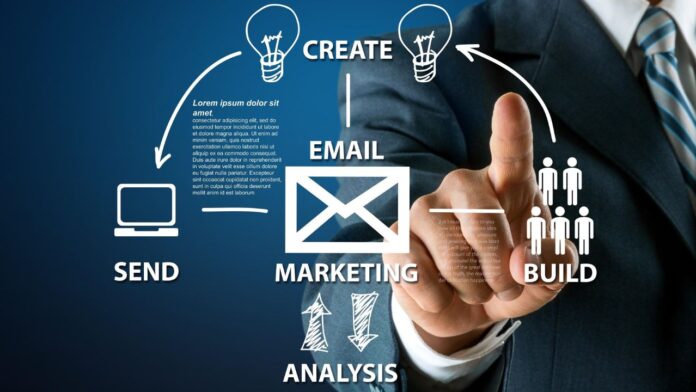To find email marketing clients, start by building a targeted email list. Utilize social media, networking events, and online directories to connect with potential clients. Craft a compelling portfolio showcasing your expertise, and offer free resources or webinars to demonstrate your value. Cold emailing and outreach can also be effective strategies to attract potential clients interested in your email marketing services.
To find email marketing clients:
- Start by building a strong portfolio of past campaigns.
- Utilize social media, networking events, and online platforms to connect with potential clients.
- Offer free webinars, create compelling content, and consider using email marketing software to showcase your expertise.
Cold outreach and leveraging your professional network can also help secure clients looking to enhance their email marketing strategies.
A brief explanation of email marketing
Email showcasing is a computerized promoting system that includes sending designated messages to a rundown of supporters or likely clients. It’s a practical way for organizations to speak with their crowd, advance items or administrations, and construct client connections. Email promoting expects to connect with beneficiaries and drive transformations through customized content and vital timing, making it an important device in the showcasing tool stash.
Importance of finding email marketing clients
Finding email marketing clients is crucial for businesses seeking to effectively connect with their target audience. It enables direct communication, fosters brand loyalty, and drives revenue growth. By identifying and nurturing email marketing clients, companies can personalize content, build relationships, and convert prospects into loyal customers, ultimately enhancing their marketing strategies‘ overall success.

Identifying Your Target Market
Recognizing your objective market is a basic move toward any fruitful business technique. It includes understanding your ideal client, directing top-to-bottom exploration on expected clients, and making client personas. This thorough aid will walk you through these fundamental parts of target market ID, assisting you with refining your promoting endeavours and lift your business’ prosperity.
- Defining Your Ideal Client: Before effectively reaching your target market, you must define your ideal client. This involves understanding who your product or service is tailored for. Here are the key components of defining your ideal client:
- Socioeconomics: Consider factors like age, orientation, pay, schooling, and area relevant to your offering. b. Psychographics: Dive into their values, beliefs, interests, and lifestyles to create a more holistic understanding.
- Pain Points: Recognize the issues or difficulties your ideal client faces that your product or service can solve.d. Buying Behavior: Analyze their purchasing habits, preferred channels, and decision-making processes.
- Researching Potential Clients: To pinpoint your target market accurately, you’ll need to conduct thorough research. Here’s how to go about it:
- Market Analysis: Assess your industry’s overall market conditions, trends, and competitive landscape.
- Customer Surveys: Collect feedback from existing customers to gain insights into their needs and preferences.
- Competitor Analysis: Study your competitors’ customer base, pricing strategies, and marketing tactics.
- Social Media Insights: Use online entertainment investigation to identify potential clients’ demographics and interests.
- Online Tools: Explore market research tools and databases to access valuable data about your target audience.
- Creating a Client Persona: A client persona is a detailed, fictional representation of your ideal client. It helps humanize your target market and guides your marketing efforts. Here’s how to create one:
- Name and Background: Give your persona a name and provide basic details like age, gender, and profession.
Building Your Email List

In digital marketing, a robust email list is one of the most valuable assets a business can cultivate. An email list is an immediate line of correspondence with your crowd, permitting you to sustain connections, share important substance, and advance your items or administrations. In this exhaustive aid, we will investigate three vital methodologies for building and growing your email list:
- Creating a Lead Magnet: A lead magnet is the cornerstone of successful email list building. You provide a compelling offer or resource to your crowd in return for their email addresses. This can be anything from an informative e-book, a useful template, an exclusive webinar, or a discount code.
- The key is to make your lead magnet irresistible and highly relevant to your target audience. Create content that tends to their trouble spots and offers solutions, ensuring that the perceived value of your lead magnet is high. Once you have a valuable lead magnet, promote it across your digital channels to attract potential subscribers.
- Offering Incentives for Sign-Ups: Incentives are vital in encouraging website visitors or social media followers to join your email list. Consider offering incentives such as a welcome discount, early access to new products or content, or entry into exclusive giveaways or contests.
- These incentives create a sense of immediate benefit for subscribers and can significantly boost your sign-up rates. Be straightforward about what supporters can hope to get and how frequently they will hear from you to set clear expectations and build trust.
- Utilizing Social Media and Other Platforms: Web-based entertainment and other internet-based stages are useful assets for growing your email list. Leverage your online presence to drive traffic to your lead magnet and encourage sign-ups.
Building a Strong Online Presence
Building areas of strength for a presence is fundamental in the present computerized age. It involves establishing a robust online identity through websites, social media, and content creation.
This presence enhances visibility, credibility, and engagement with your target audience. It’s a vital tool for businesses, individuals, and organizations to connect, share information, and build lasting relationships in the digital realm.
Developing a professional website and portfolio
Creating a professional website and portfolio is essential for showcasing your skills and accomplishments. A well-designed website serves as an online resume and a powerful tool for networking and career growth.
It permits you to introduce your work, share your skills, and establish a long-term connection with expected businesses or clients, upgrading your expert presence in the computerized world.
Optimizing your website for search engines
Upgrading your site for web crawlers is the way to improve its visibility and attract organic traffic. You can climb search engine rankings by strategically incorporating relevant keywords, optimizing meta tags, enhancing site speed, and ensuring mobile-friendliness.
This process helps potential customers find your site easily, boosting your online presence and driving growth for your business.
Showcasing your expertise through blog posts and case studies
Showcasing your expertise through blog posts and case studies is a powerful way to demonstrate your knowledge and skills. In these informative pieces, you can delve into industry insights, share valuable experiences, and provide tangible examples of your capabilities.
This establishes credibility and helps potential clients or employers understand the depth of your expertise.
Networking and Collaboration
Systems administration and coordinated effort are fundamental mainstays of present-day proficient achievement. Organizing includes building important associations with friends and industry experts, and cultivating amazing open doors for development and learning.
Conversely, collaboration encourages teamwork and the exchange of ideas, enhancing innovation and productivity. Together, these concepts create a dynamic synergy that drives personal and collective achievement in today’s interconnected world.
Attending industry events and conferences
Going to industry occasions and meetings gives significant systems administration open doors and experiences into the most recent patterns and advancements. It allows professionals to connect with peers, exchange ideas, and stay updated on industry developments.
These gatherings foster collaboration, learning, and the chance to build meaningful relationships that can enhance one’s career and contribute to business growth.
Joining relevant online communities and forums
Partaking in pertinent web-based networks and discussions is a significant method for interfacing with similar people, sharing information, and looking for counsel.
These digital spaces offer opportunities to engage in discussions, expand one’s network, and gain insights into specific interests or industries.
Joining such communities can enhance your online presence and provide a platform for learning and collaboration.
Collaborating with complementary service providers
Collaborating with complementary service providers involves partnering with businesses or professionals whose offerings complement your own.
This strategic alliance allows for a more comprehensive and value-added solution for clients, enhancing customer satisfaction and expanding market reach.
Organizations can deliver a seamless and holistic experience by pooling resources and expertise, fostering mutual growth and success.
Proactive Outreach and Lead Generation
Proactive outreach and lead generation refer to strategic efforts to identify and engage potential customers or clients before they actively seek your products or services.
This proactive approach involves targeted marketing, communication, and relationship-building to create opportunities for businesses to connect with and convert prospects into valuable leads, ultimately fostering growth and success.
Creating a compelling email marketing proposal
An effective email marketing proposal involves strategically outlining a tailored campaign that captivates your audience. It encompasses defining objectives, segmenting your audience, creating engaging content, and tracking performance metrics. By presenting a well-structured proposal, you can convey your expertise and demonstrate how email marketing will drive results for your client or organization.
Utilizing social media platforms for lead generation
Using online entertainment stages for lead age includes tackling the force of stages like Facebook, Twitter, and LinkedIn to distinguish and draw in possible clients.
By crafting compelling content, targeted ads, and strategic outreach, businesses can build relationships, capture valuable contact information, and ultimately convert these leads into loyal customers, driving growth and success in the digital age.
Reaching out to potential clients through personalized emails
Reaching out to potential clients through personalized emails involves crafting tailored messages that resonate with individual recipients. This approach fosters a genuine connection, addressing specific needs and interests. By acknowledging their unique requirements, personalized emails enhance engagement, trust, and the likelihood of forging meaningful business relationships.
How to Find Email Marketing Clients

To find email marketing clients:
- Start by building a targeted email list.
- Utilize social media, networking events, and online directories to connect with potential clients.
- Craft a compelling portfolio showcasing your expertise, and offer free resources or webinars to demonstrate your value.
Cold emailing and outreach can also be effective strategies to attract potential clients interested in your email marketing services.
Finding email marketing clients requires a strategic approach.
Finding email marketing clients demands a thoughtful, systematic approach. Effective strategies encompass identifying target demographics, crafting compelling email campaigns, and networking to establish trust.
Building a robust client base hinges on understanding client needs, showcasing expertise, and delivering value through tailored email marketing solutions. Success in this field relies on strategic thinking and a proactive approach to client acquisition.
Identifying your target audience and building a strong online presence are crucial.
In today’s digital landscape, identifying your target audience and establishing a robust online presence are pivotal for success. Understanding your audience’s preferences and needs allows for tailored engagement, while a strong online presence across various platforms enhances visibility and credibility. These strategies are essential for businesses and individuals alike in the digital age.
Networking, collaboration, and proactive outreach play key roles in client acquisition.
In client acquisition, networking, collaboration, and proactive outreach are pivotal strategies. Networking fosters valuable connections, while collaboration leverages collective expertise.
Proactive outreach ensures that potential clients are engaged effectively. These three elements synergize to create a dynamic approach that enhances the acquisition of clients and fosters sustainable business growth.
Conclusion
Finding email marketing clients requires strategic planning, networking, and marketing efforts. You can attract the right clients who value your expertise and services by identifying your target audience, building a strong portfolio, and leveraging various marketing channels.
Remember that client acquisition is ongoing, so stay persistent and adaptable. With time and dedication, your email marketing client base grows, leading to a thriving business.
FAQ:
What Tools Can Help in Finding Email Marketing Clients?
Several tools can aid in your quest for email marketing clients:
Email Outreach Tools: Platforms like Mailshake or Outreach.io can streamline your cold email campaigns.
LinkedIn: Use LinkedIn Premium to access advanced networking features and reach potential clients.
How Long Does It Take to Find Email Marketing Clients?
The time it takes to find email marketing clients varies depending on factors such as your niche, networking efforts, and the quality of your outreach. It may take a few weeks to several months.
How Can I Stand Out From the Competition?
To stand out, focus on your unique selling points. Showcase your expertise, share success stories, and emphasize the value you can bring to your clients. Personalize your outreach and demonstrate a deep understanding of your client’s industry.
Should I Offer Free Services to Attract Clients?
While offering a free consultation or a limited-service trial can attract clients, be cautious not to undervalue your expertise. Ensure that any free services you provide have the potential to convert into paid projects.



